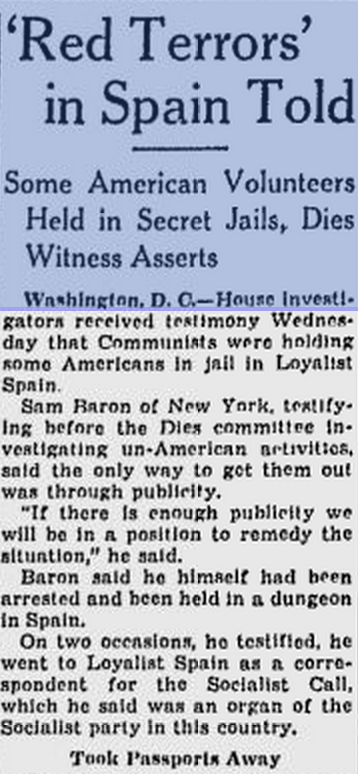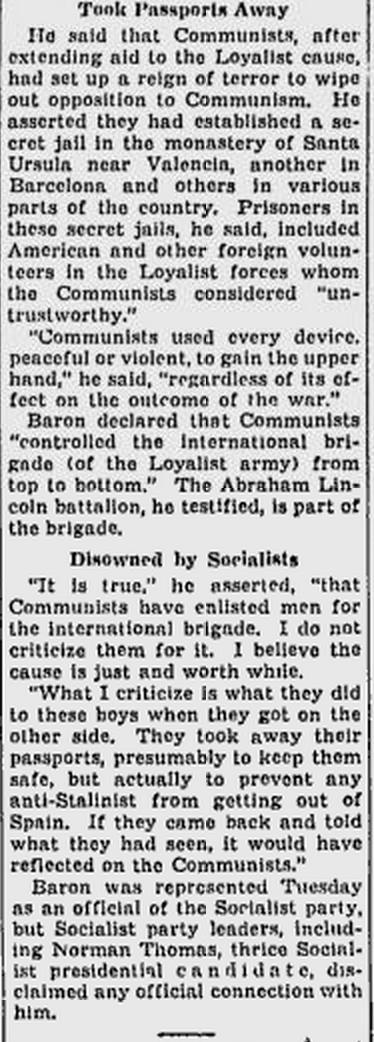
In the May 1 and 2 pages, Merriman notes that Sam Baron comes to Albacete and on May 3 he goes to the training base at Madrigueras. Perhaps somewhat tongue-in-cheek Merriman mentions a “plot” to keep Baron from meeting up with Amlie in Madrigueras and to keep them apart, he brings Amlie to Pozorubio, the Officer’s Training School. While they didn’t stay separated, Amlie did meet with Baron but it had little effect not the outcome, since by the end of May 4 Amlie is in Pozorubio and has decided to join the Communist Party, clearly a coup for the CPUSA and Spanish Communists.


Who was Sam Baron that he had this effect on the Internationals? Baron was a member of the Socialist Party of the US, a reporter for the New York Call newspaper (to become the Socialist Call) and moreover was a “right wing” member of the SP. In the early 20th Century, the Socialist Party had splits where left wing and right wing elements were both allowed to coexist within the party. The “right wing” had more anarchistic tendencies and were called “the Kangaroo faction”.
The testimony of Baron later in 1938 shows his anti-communist leanings and he accuses the Loyalist Government in Spain of having him locked up twice while he was there as a correspondent.
Clearly, the intrigue about using Amlie as a wedge against the Socialists who failed to deliver the Eugene V. Debs column to Spain as part of the International Brigades was an important political effort on the part of the CP to assume sole leadership of the Internationals in Spain. The involvement of Ernest Bromley of the Communist Party of Great Britain points out the political involvement of the activities in Albacete. {Alec} Donaldson came in to meet with this important British delegate.

We find that David Mates has come to Albacete and a new name is introduced, Mirko Markovics (or Marcovich). Marcovics, a Yugoslavian, had been in Moscow before the war and was on a list of “Mexicans” who came to Spain.
Marion Merriman relates her impressions of Marcovics:¹
A Yugoslav-American officer, Mirko Markovicz, who had once made a play for me, only to be rebuffed, came to me one day. He told me he happened to notice on Bob’s desk at headquarters a letter in Russian from a woman in Moscow. The woman’s name was Klava {Klava had made advances to Bob Merriman in Moscow and Marion did not know what had really gone on between them}. I immediately felt weak and shaky, insecure, as though I were being told Bob had received a letter from a lover. I remembered Klava, the young blonde Russian who had tried so desperately to attract Bob in Moscow. I was perplexed. Markovicz knew it. He was cunning.
But I quickly realized what Markovicz was doing. He was attempting to separate Bob and me by making me suspicious of Bob. He — it surely was thought — would fill in the breach. Distrusting Bob, I would turn to him. Well, how wrong he was! I remembered what I thought of Klava, how I felt sorry for her, how I realized she was reaching out to a strong man, a man she could not have, for love.
I told Bob that I was aware a letter had come from Klava. And I told him that Markovicz, who was one of the more important American volunteer commanders, having taken over the George Washington Battalion {more later on this Battalion}, was attempting to cause a problem between us. Bob was outraged that Marcovicz would read his mail. Despite his fury, he told me he would keep it within himself. He would not trust Marcovicz ever again, but he would not allow Marcovicz’s lack of scruples to affect the relationship of command needed in fighting the war.¹
Some new names are mentioned including a “Roblet”, who is described in Vidal’s memoir as having come from “Mission S”.² Marcovics comes to the school with a man named Clerc, who Vidal tells us was the Commander of the 2nd Company of the 10th Battalion Machine Battalion of the XIIth (French) Brigade.² André Clerc was an instructor at the school but was killed in action in October 1937. Merriman reveals that Walter Garland may return to the US where he could be used for recruiting and fundraising purposes. Canadian Edward Cecil-Smith will go to Madrigueras as a company commander and will move up as the third North American English speaking brigade begins to form over the summer.
Training continued on May 4 with “Carlos” giving the lecture. Carlos was a nom-de-guerre for an Italian comrade. Carlos will lecture several times over the next month and in June, he will assume command in place of General Gal. He will be named in the May 7-8 diary page.
Vladimir Copic’s diary says that on May 3, the XVth Brigade was ordered back into the trenches at Jarama through “high military orders”. After 75 days at the front, the XVth got a grand total of four days rest.³
____________________________________
¹ Marion Merriman Wachtel and Warren Lerude, American Commander in Spain, ibid., pg 146-147.
² Gayman, Vital (Vidal) “The Base of the International Brigades in Albacete 1936-1937″, RGASPI Archives Fond 545 Opus 2 Delo 32, BDIC Library, Nanterre, France (can be also accessed at Tamiment Library, NYU, from the microfilms). {In hardcopy as Vital Gayman, Vital Gayman et la Base des Brigades Internationales d’Albacete en 1936.1938, Fondº Δ rés 744/1, Bibliothèque de Documentation Internationale Contemporaine (BDIC), 6, allée de l’Université Nanterre Cedex F-92001 France}
³ Comintern microfilm Fond 545 Opus 3 Delo 467, Tamiment Library, New York University Bobst Library.
